

Compact Muon Solenoid
LHC, CERN
| CMS-PAS-B2G-18-005 | ||
| Search for pair production of vector-like quarks in the fully hadronic channel | ||
| CMS Collaboration | ||
| March 2019 | ||
| Abstract: The results of two searches for vector-like T or B quark pair production using the fully hadronic final state are presented, using data from the CMS experiment at a center of mass energy of 13 TeV collected during the 2016 run, corresponding to an integrated luminosity of 35.9 fb−1. A multiclassification algorithm, the "boosted event shape tagger'', is deployed to label candidate jets as originating from top quarks, W, Z, or Higgs bosons. Candidate events are categorized according to the multiplicities of heavy objects observed in the final state, and the scalar sum of all observed jet momenta is used to discriminate signal events from the QCD multijet background. This novel strategy is complemented by a second, cut-based analysis that specifically targets the bW decay mode of the T quark, and allows for the reconstruction of the T quark candidates, providing additional sensitivity. Both analyses probe all possible branching fraction combinations of the T and B quarks and set limits on their masses, ranging from 740 to 1370 GeV. These results represent a significant improvement relative to existing searches in the fully hadronic final state. | ||
|
Links:
CDS record (PDF) ;
CADI line (restricted) ;
These preliminary results are superseded in this paper, PRD 100 (2019) 072001. The superseded preliminary plots can be found here. |
||
| Figures | |
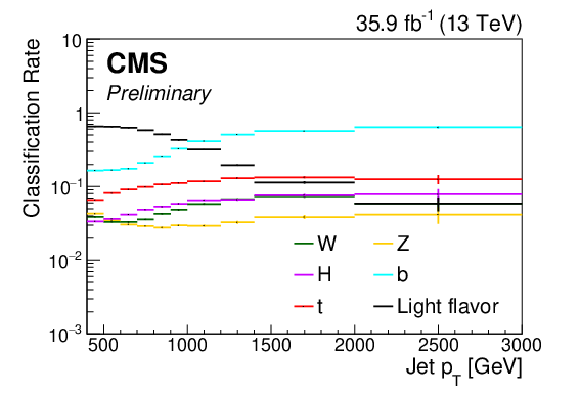
png pdf |
Figure 1:
Classification rates for the six categories of the BEST algorithm, as measured in data events as a function of jet pT. Error bars shown indicate statistical errors on the rates to be propagated to the estimate of the QCD multijet background contribution. The value of the rate in the rightmost bin is also used for jets with pT values above 3 TeV. |
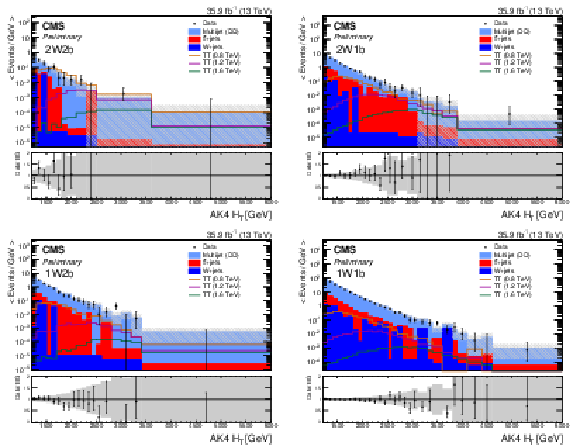
png pdf |
Figure 2:
The distributions of HAK4T for each of the four signal region categories in the cut-based analysis. The top row shows channels with 2 W tags, and 2, 1 b tags respectively. The bottom row is for 1 W tag. The shaded error band represents the statistical uncertainty in the background. These distributions reflect the nuisance parameters evaluated after a likelihood fit to a background plus signal hypothesis, where the hypothesized signal is a T quark with a mass of 1200 GeV and 100% branching fraction to bW. The signal distributions show the expected yield of events assuming the cross section values in Table 1. The vertical axis label denotes that bin contents in these distributions have been scaled by their corresponding bin widths. |
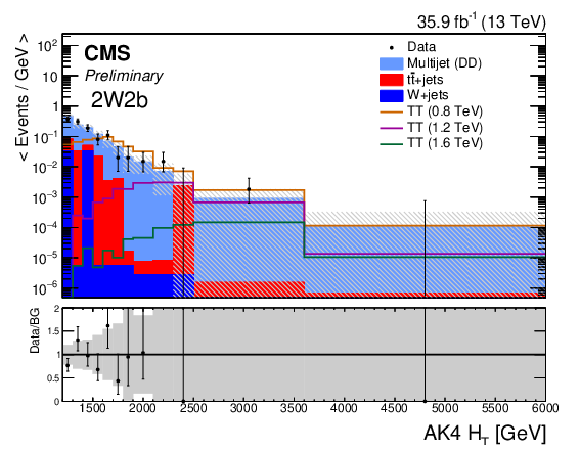
png pdf |
Figure 2-a:
The distribution of HAK4T for the 2 W tags, 2 b tags signal region category in the cut-based analysis. The shaded error band represents the statistical uncertainty in the background. The distribution reflects the nuisance parameters evaluated after a likelihood fit to a background plus signal hypothesis, where the hypothesized signal is a T quark with a mass of 1200 GeV and 100% branching fraction to bW. The signal distribution shows the expected yield of events assuming the cross section values in Table 1. The vertical axis label denotes that bin contents in these distributions have been scaled by their corresponding bin widths. |
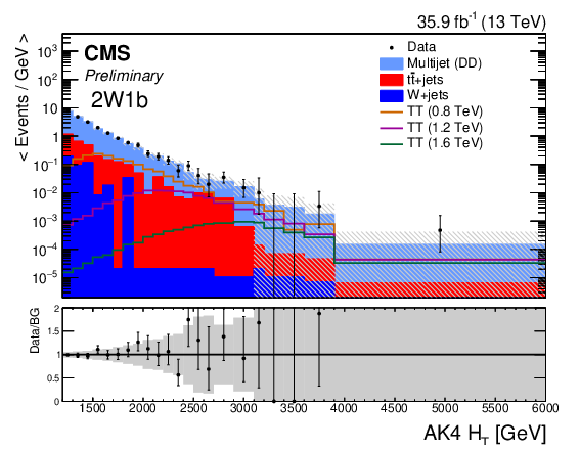
png pdf |
Figure 2-b:
The distribution of HAK4T for the 2 W tags, 1 b tags signal region category in the cut-based analysis. The shaded error band represents the statistical uncertainty in the background. The distribution reflects the nuisance parameters evaluated after a likelihood fit to a background plus signal hypothesis, where the hypothesized signal is a T quark with a mass of 1200 GeV and 100% branching fraction to bW. The signal distribution shows the expected yield of events assuming the cross section values in Table 1. The vertical axis label denotes that bin contents in these distributions have been scaled by their corresponding bin widths. |
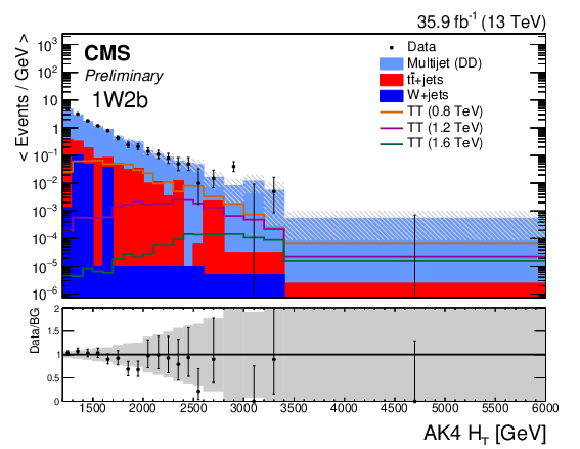
png pdf |
Figure 2-c:
The distribution of HAK4T for the 1 W tag, 2 b tags signal region category in the cut-based analysis. The shaded error band represents the statistical uncertainty in the background. The distribution reflects the nuisance parameters evaluated after a likelihood fit to a background plus signal hypothesis, where the hypothesized signal is a T quark with a mass of 1200 GeV and 100% branching fraction to bW. The signal distribution shows the expected yield of events assuming the cross section values in Table 1. The vertical axis label denotes that bin contents in these distributions have been scaled by their corresponding bin widths. |
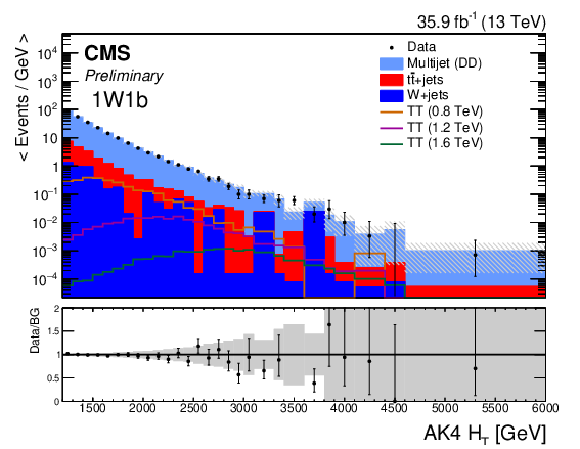
png pdf |
Figure 2-d:
The distribution of HAK4T for the 1 W tag, 1 b tags signal region category in the cut-based analysis. The shaded error band represents the statistical uncertainty in the background. The distribution reflects the nuisance parameters evaluated after a likelihood fit to a background plus signal hypothesis, where the hypothesized signal is a T quark with a mass of 1200 GeV and 100% branching fraction to bW. The signal distribution shows the expected yield of events assuming the cross section values in Table 1. The vertical axis label denotes that bin contents in these distributions have been scaled by their corresponding bin widths. |
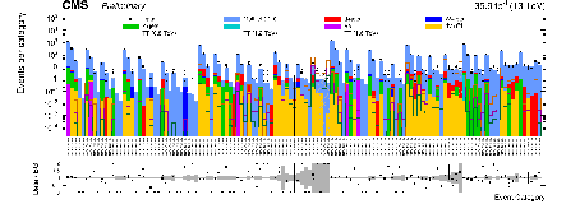
png pdf |
Figure 3:
A summary of the 126 signal region categories used in the NN analysis. This figure shows the expected yields in each category, while the signal discrimination is performed with the HAK8T distributions from each of the categories. The bottom panel shows the ratio of observed data to total background in each category, with Poisson error bars where applicable, along with the total background uncertainty shown for each category by the gray band. |

png pdf |
Figure 4:
Distributions of HAK8T for all events entering the 126 signal regions of the NN analysis (top left), as well as for only categories containing at least one candidate of each of the particle types identified by the BEST algorithm. The plots shown here are not mutually exclusive, as the signal region may satisfy several of the criteria for the individual summary categories. The vertical axis label denotes that bin contents in these distributions have been scaled by their corresponding bin widths. |
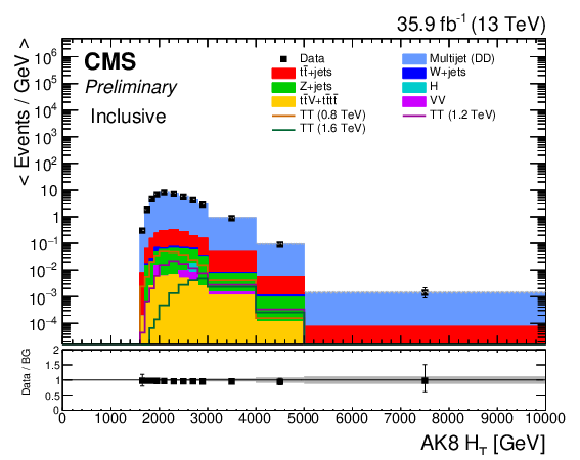
png pdf |
Figure 4-a:
Distribution of HAK8T for all events entering the 126 signal regions of the NN analysis. The plot shown here is not exclusive, as the signal region may satisfy several of the criteria for the individual summary categories. The vertical axis label denotes that bin contents in the distribution have been scaled by their corresponding bin widths. |
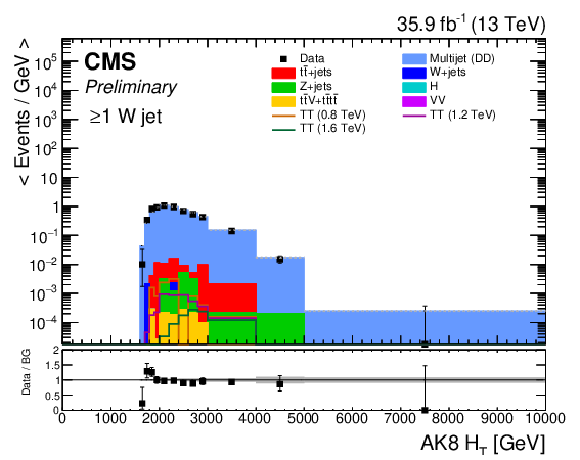
png pdf |
Figure 4-b:
Distribution of HAK8T for only the category containing at least one W by the BEST algorithm. The plot shown here is not exclusive, as the signal region may satisfy several of the criteria for the individual summary categories. The vertical axis label denotes that bin contents in the distribution have been scaled by their corresponding bin widths. |
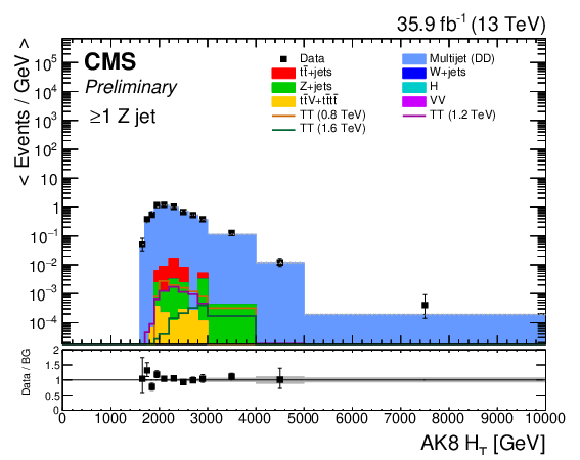
png pdf |
Figure 4-c:
Distribution of HAK8T for only the category containing at least one Z identified by the BEST algorithm. The plot shown here is not exclusive, as the signal region may satisfy several of the criteria for the individual summary categories. The vertical axis label denotes that bin contents in the distribution have been scaled by their corresponding bin widths. |

png pdf |
Figure 4-d:
Distribution of HAK8T for only the category containing at least one H identified by the BEST algorithm. The plot shown here is not exclusive, as the signal region may satisfy several of the criteria for the individual summary categories. The vertical axis label denotes that bin contents in the distribution have been scaled by their corresponding bin widths. |
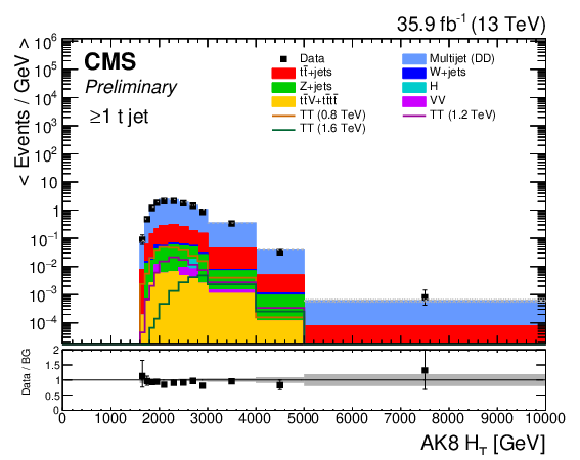
png pdf |
Figure 4-e:
Distribution of HAK8T for only the category containing at least one t jet identified by the BEST algorithm. The plot shown here is not exclusive, as the signal region may satisfy several of the criteria for the individual summary categories. The vertical axis label denotes that bin contents in the distribution have been scaled by their corresponding bin widths. |
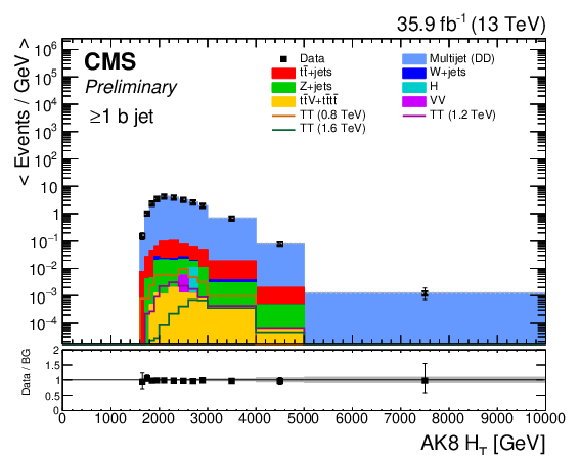
png pdf |
Figure 4-f:
Distribution of HAK8T for only the category containing at least one b jet identified by the BEST algorithm. The plot shown here is not exclusive, as the signal region may satisfy several of the criteria for the individual summary categories. The vertical axis label denotes that bin contents in the distribution have been scaled by their corresponding bin widths. |
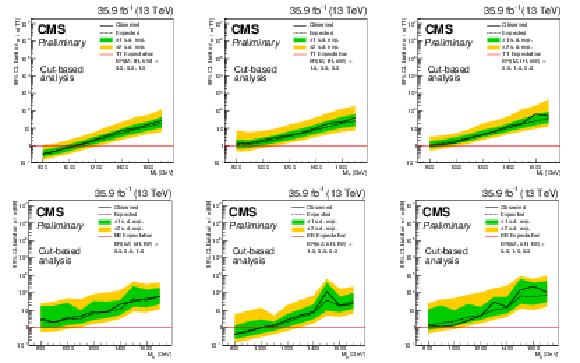
png pdf |
Figure 5:
Limits on the pair production cross section for T quarks (top) and B quarks (bottom) in the cut-based analysis, with decays solely to bW/tW (left), tZ/bZ (middle), and tH/bH (right). |

png pdf |
Figure 5-a:
Limits on the pair production cross section for T quarks in the cut-based analysis, with decays solely to bW/tW. |
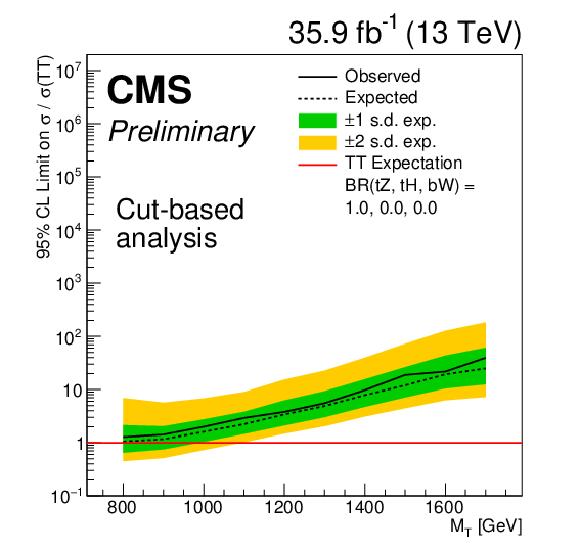
png pdf |
Figure 5-b:
Limits on the pair production cross section for T quarks in the cut-based analysis, with decays solely to tZ/bZ. |
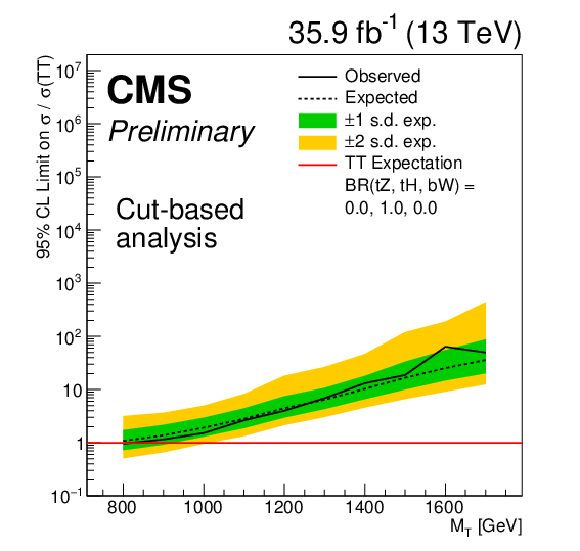
png pdf |
Figure 5-c:
Limits on the pair production cross section for T quarks in the cut-based analysis, with decays solely to tH/bH. |
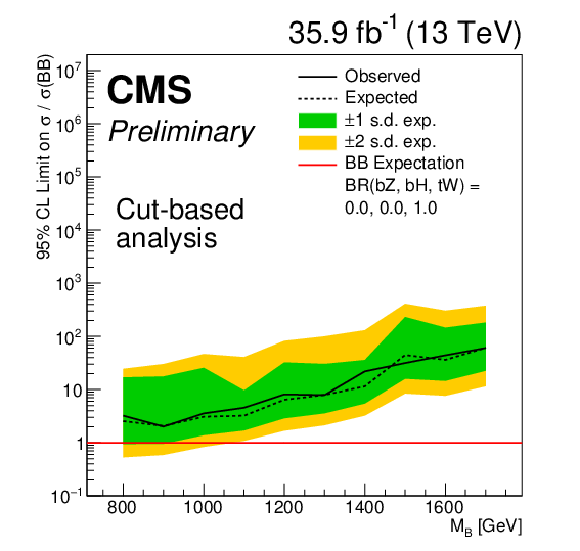
png pdf |
Figure 5-d:
Limits on the pair production cross section for B quarks in the cut-based analysis, with decays solely to bW/tW. |

png pdf |
Figure 5-e:
Limits on the pair production cross section for B quarks in the cut-based analysis, with decays solely to tZ/bZ. |
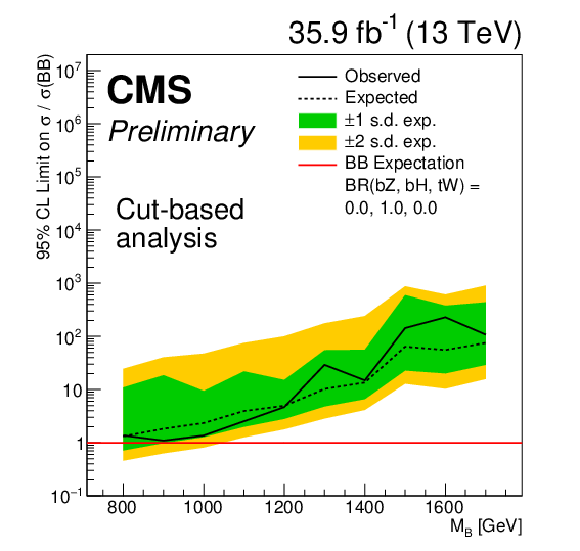
png pdf |
Figure 5-f:
Limits on the pair production cross section for B quarks in the cut-based analysis, with decays solely to tH/bH. |
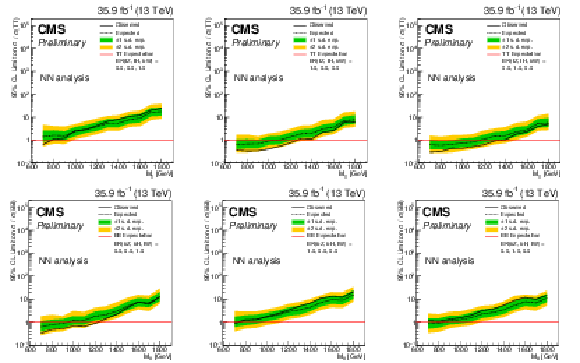
png pdf |
Figure 6:
Limits on the pair production cross section for T quarks (top) and B quarks (bottom) in the NN analysis, with decays solely to bW/tW (left), tZ/bZ (middle), and tH/bH (right). |
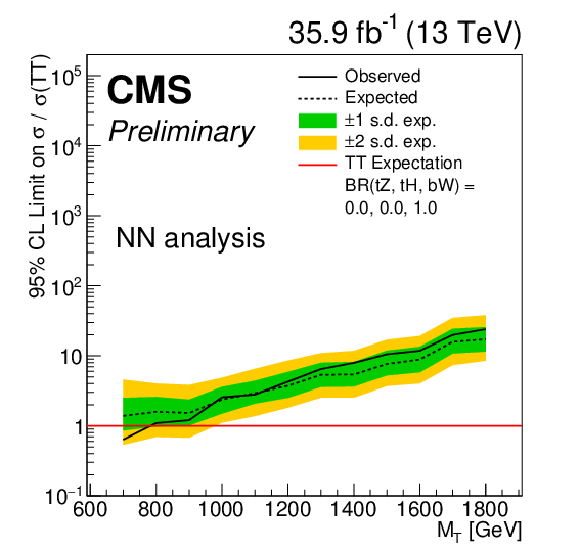
png pdf |
Figure 6-a:
Limits on the pair production cross section for T quarks in the NN analysis, with decays solely to bW/tW. |
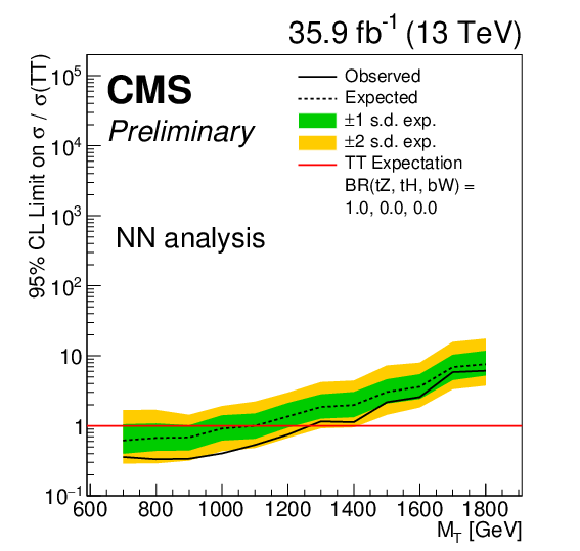
png pdf |
Figure 6-b:
Limits on the pair production cross section for T quarks in the NN analysis, with decays solely to tZ/bZ. |
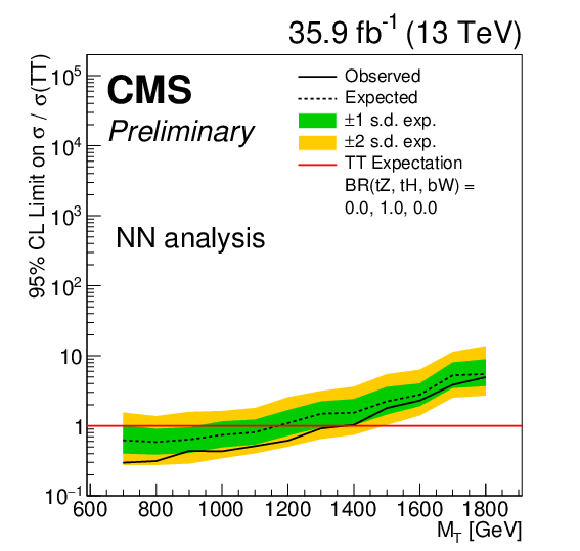
png pdf |
Figure 6-c:
Limits on the pair production cross section for T quarks in the NN analysis, with decays solely to tH/bH. |
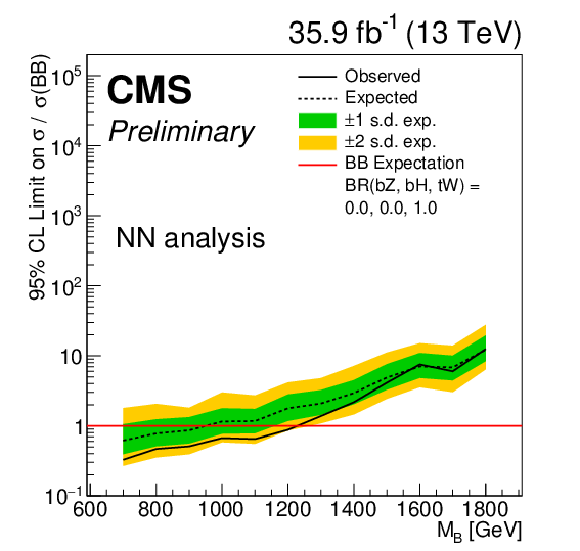
png pdf |
Figure 6-d:
Limits on the pair production cross section for B quarks in the NN analysis, with decays solely to bW/tW. |
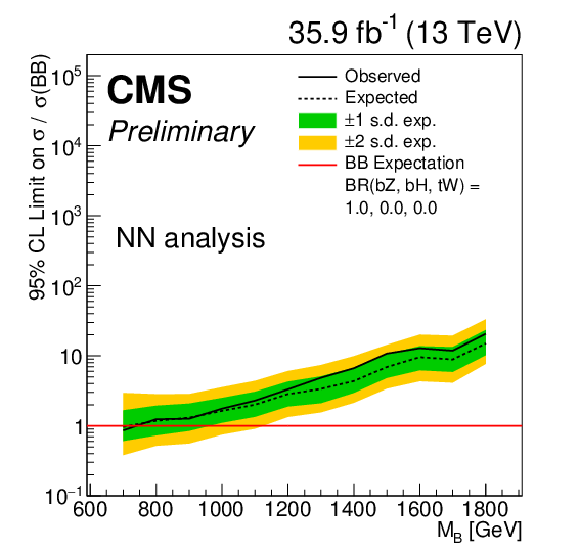
png pdf |
Figure 6-e:
Limits on the pair production cross section for B quarks in the NN analysis, with decays solely to tZ/bZ. |
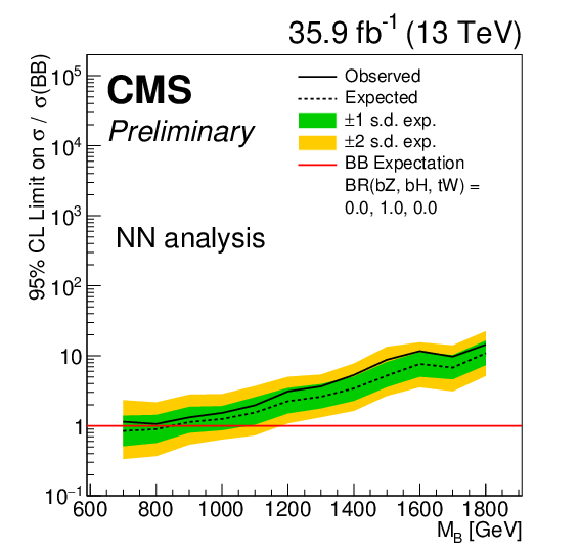
png pdf |
Figure 6-f:
Limits on the pair production cross section for B quarks in the NN analysis, with decays solely to tH/bH. |
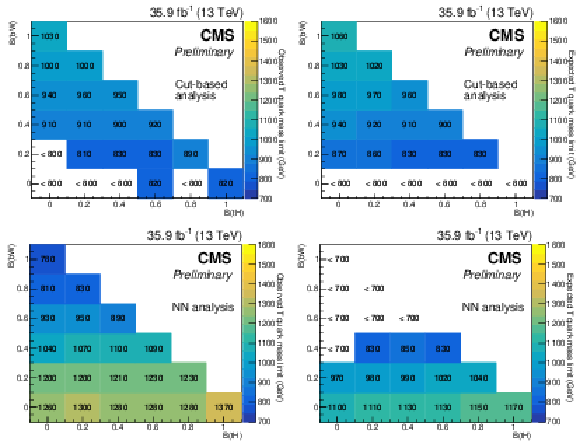
png pdf |
Figure 7:
Observed (left) and expected (right) mass exclusion limits for each combination of T quark branching fractions, in the cut-based analysis (top) and NN analysis (bottom). |
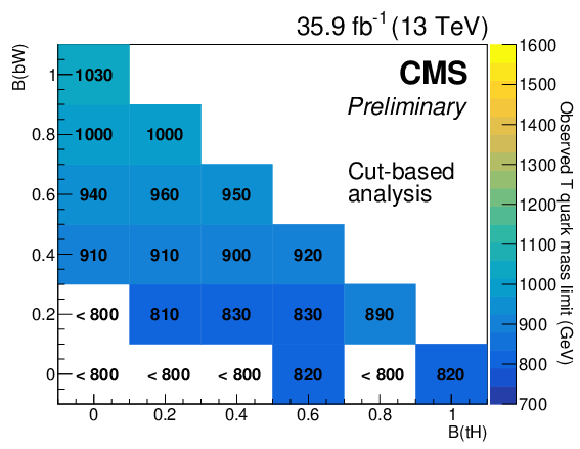
png pdf |
Figure 7-a:
Observed mass exclusion limits for each combination of T quark branching fractions, in the cut-based analysis. |
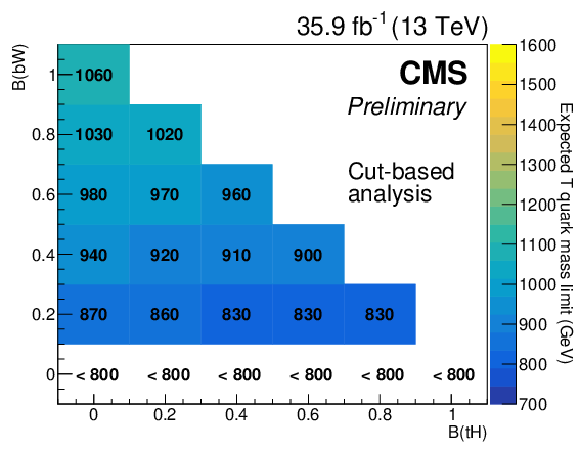
png pdf |
Figure 7-b:
Expected mass exclusion limits for each combination of T quark branching fractions, in the cut-based analysis. |
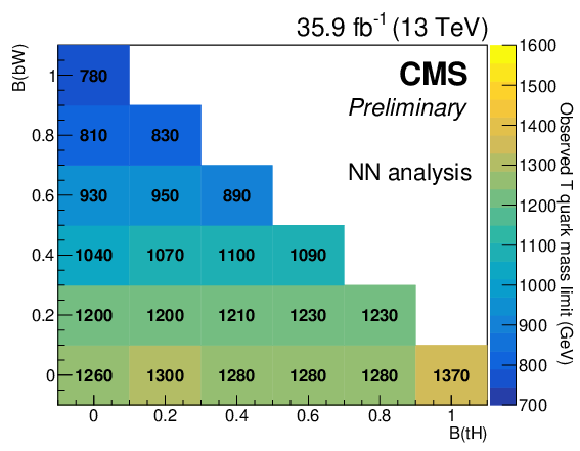
png pdf |
Figure 7-c:
Observed mass exclusion limits for each combination of T quark branching fractions, in the NN analysis. |
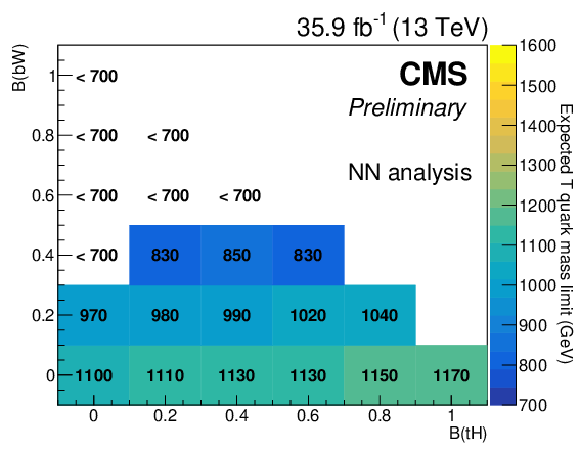
png pdf |
Figure 7-d:
Expected mass exclusion limits for each combination of T quark branching fractions, in the NN analysis. |
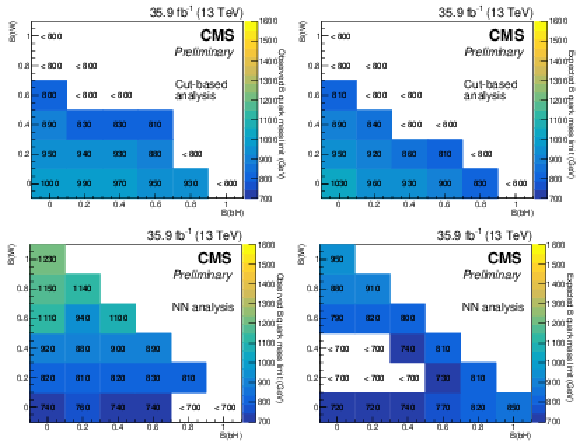
png pdf |
Figure 8:
Observed (left) and expected (right) mass exclusion limits for each combination of B quark branching fractions, in the cut-based analysis (top) and NN analysis (bottom). |
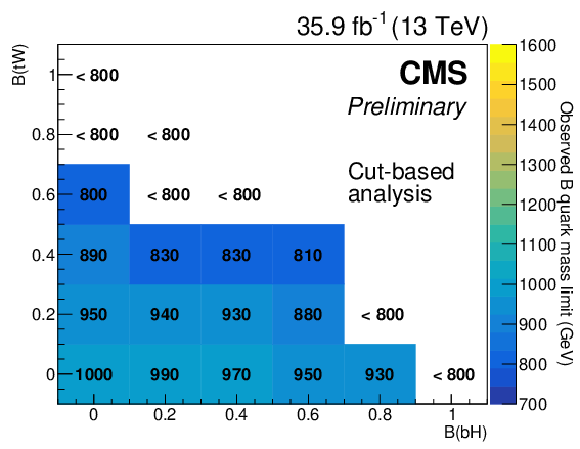
png pdf |
Figure 8-a:
Observed mass exclusion limits for each combination of B quark branching fractions, in the cut-based analysis. |
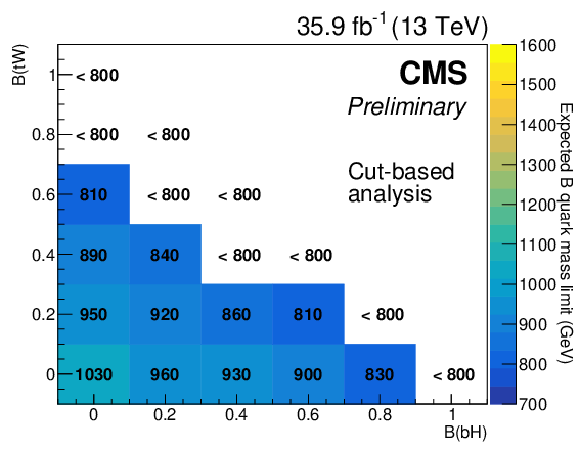
png pdf |
Figure 8-b:
Expected mass exclusion limits for each combination of B quark branching fractions, in the cut-based analysis. |
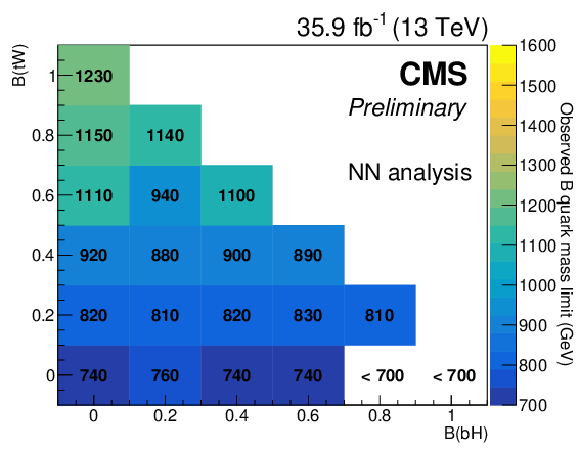
png pdf |
Figure 8-c:
Observed mass exclusion limits for each combination of B quark branching fractions, in the NN analysis. |

png pdf |
Figure 8-d:
Expected mass exclusion limits for each combination of B quark branching fractions, in the NN analysis. |
| Tables | |

png pdf |
Table 1:
Theoretical cross sections for TT and BB production. |
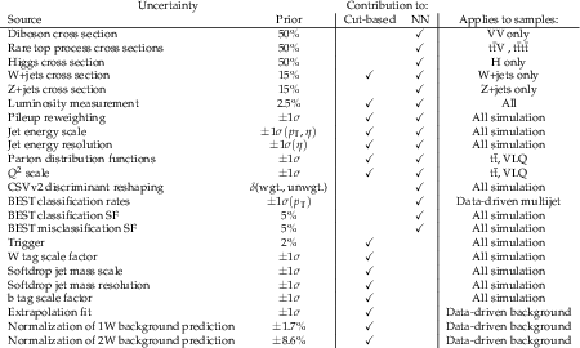
png pdf |
Table 2:
Sources of systematic uncertainties that affect the HAK4T or HAK8T distribution in each analysis. Systematic sources with a prior uncertainty of "±1σ'' affect the shape, all others affect the rate only. |
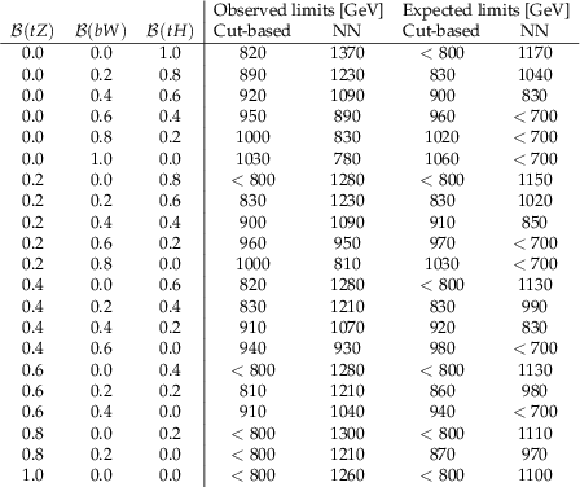
png pdf |
Table 3:
Exclusion limits presented in terms of the T quark mass, for the different branching fraction scenarios considered, in each of the two analyses. |
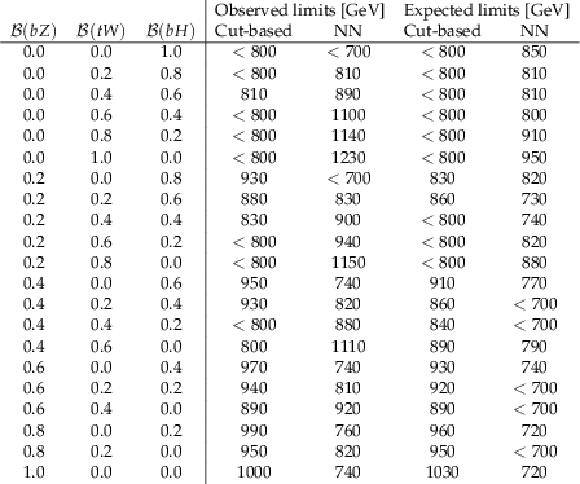
png pdf |
Table 4:
Exclusion limits presented in terms of the B quark mass, for the different branching fraction scenarios considered, in each of the two analyses. |
| Summary |
|
Two independent searches for vector-like T and B quarks using the fully hadronic final state are presented. Both searches use data collected by the CMS experiment in 2016, corresponding to an integrated luminosity of 35.9 fb−1. A cut-based analysis, using jet substructure observables to identify hadronic decays of boosted W bosons, targets the bW decay mode of the T quark, and improves sensitivity relative to previous results most sensitive to the same decay mode. The cut-based analysis uses a data-driven QCD multijet estimation method based on shape and rate extrapolations from various control regions to the signal region. Improvements in W-tagging techniques, as well as additional signal regions requiring just a single W-tagged jet, enhance the performance of this analysis relative to previous strategies. The cut-based analysis extends the B quark mass exclusion to 1.03 TeV, relative to the previous exclusion of 705 GeV, obtained by a similar analysis targeting the bW decay mode using data collected at √s= 8 TeV [50]. A new strategy is presented and compared with the traditional cut-based approach. The NN analysis uses a multiclassification technique, the BEST algorithm, to identify jets originating from heavy objects such as t or b quarks, and W, Z, or Higgs bosons. This allows the analysis to be sensitive to all decay modes of the T and B quarks. Using classification rates, the dominant QCD multijet background is estimated using observed data. The NN analysis provides sensitivity for the tH and tZ decay modes competitive with that obtained by other searches utilizing lepton+jets or multilepton topologies. For each analysis, results are presented in terms of cross section limits for the pair production of T and B quarks, along with exclusion limits in terms of the T and B quark masses, for the different combinations of branching fractions considered. The analyses presented here provide additional sensitivity for a possible combination result including all final states targeting VLQ production in CMS. The mass exclusion limits for the NN analysis range from 700-1370 GeV, providing comparable sensitivity to the searches utilizing leptons, which exclude VLQ masses in the range 910-1300 GeV. These results represent the most stringent limits on vector-like quarks in the fully hadronic channel to date. |
| References | ||||
| 1 | ATLAS Collaboration | Observation of a new particle in the search for the standard model higgs boson with the ATLAS detector at the LHC | Physics Letters B 716 (2012) 1 | 1207.7214 |
| 2 | CMS Collaboration | Observation of a new boson at a mass of 125 GeV with the CMS experiment at the LHC | Physics Letters B 716 (2012) 30 | CMS-HIG-12-028 1207.7235 |
| 3 | R. Contino, L. Da Rold, and A. Pomarol | Light custodians in natural composite Higgs models | PRD 75 (2007) 055014 | hep-ph/0612048 |
| 4 | R. Contino, T. Kramer, M. Son, and R. Sundrum | Warped/composite phenomenology simplified | JHEP 05 (2007) 074 | hep-ph/0612180 |
| 5 | D. B. Kaplan | Flavor at SSC energies: A new mechanism for dynamically generated fermion masses | NPB 365 (1991) 259 | |
| 6 | M. J. Dugan, H. Georgi, and D. B. Kaplan | Anatomy of a composite higgs model | NPB 254 (1985) 299 | |
| 7 | M. Perelstein, M. E. Peskin, and A. Pierce | Top quarks and electroweak symmetry breaking in little Higgs models | PRD 69 (2004) 075002 | hep-ph/0310039 |
| 8 | O. Matsedonskyi, G. Panico, and A. Wulzer | Light top partners for a light composite Higgs | JHEP 01 (2013) 164 | 1204.6333 |
| 9 | A. De Simone, O. Matsedonskyi, R. Rattazzi, and A. Wulzer | A first top partner hunter's guide | Journal of High Energy Physics 2013 (Apr, 2013) 4 | |
| 10 | J. A. Aguilar-Saavedra, R. Benbrik, S. Heinemeyer, and M. P\'erez-Victoria | Handbook of vectorlike quarks: Mixing and single production | PRD 88 (2013) 094010 | |
| 11 | CMS Collaboration | Search for vector-like quarks in events with two oppositely charged leptons and jets in proton-proton collisions at √s= 13 TeV | Submitted to: EPJ(2018) | CMS-B2G-17-012 1812.09768 |
| 12 | CMS Collaboration | Search for vector-like T and B quark pairs in final states with leptons at √s= 13 TeV | JHEP 08 (2018) 177 | CMS-B2G-17-011 1805.04758 |
| 13 | CMS Collaboration | Search for pair production of vector-like quarks in the bW¯bW channel from proton-proton collisions at √s= 13 TeV | PLB779 (2018) 82--106 | CMS-B2G-17-003 1710.01539 |
| 14 | ATLAS Collaboration | Search for pair production of heavy vector-like quarks decaying into hadronic final states in pp collisions at √s= 13 TeV with the ATLAS detector | PRD98 (2018) 092005 | 1808.01771 |
| 15 | ATLAS Collaboration | Combination of the searches for pair-produced vector-like partners of the third-generation quarks at √s= 13 TeV with the ATLAS detector | PRL 121 (2018) 211801 | 1808.02343 |
| 16 | CMS Collaboration | The CMS trigger system | JINST 12 (2017) P01020 | CMS-TRG-12-001 1609.02366 |
| 17 | CMS Collaboration | The CMS experiment at the CERN LHC | JINST 3 (2008) S08004 | CMS-00-001 |
| 18 | CMS Collaboration | Particle-flow reconstruction and global event description with the CMS detector | JINST 12 (2017) P10003 | CMS-PRF-14-001 1706.04965 |
| 19 | M. Cacciari, G. P. Salam, and G. Soyez | The anti-kt jet clustering algorithm | JHEP 04 (2008) 063 | 0802.1189 |
| 20 | M. Cacciari, G. P. Salam, and G. Soyez | FastJet user manual | EPJC 72 (2012) 1896 | 1111.6097 |
| 21 | Y. L. Dokshitzer, G. D. Leder, S. Moretti, and B. R. Webber | Better jet clustering algorithms | JHEP 08 (1997) 001 | hep-ph/9707323 |
| 22 | M. Wobisch and T. Wengler | Hadronization corrections to jet cross-sections in deep inelastic scattering | in Proceedings of the Workshop on Monte Carlo Generators for HERA Physics, Hamburg, Germany, p. 270 1998 | hep-ph/9907280 |
| 23 | M. Dasgupta, A. Fregoso, S. Marzani, and G. P. Salam | Towards an understanding of jet substructure | JHEP 09 (2013) 029 | 1307.0007 |
| 24 | A. J. Larkoski, S. Marzani, G. Soyez, and J. Thaler | Soft drop | JHEP 05 (2014) 146 | 1402.2657 |
| 25 | J. Thaler and K. Van Tilburg | Identifying boosted objects with N-subjettiness | JHEP 03 (2011) 015 | 1011.2268 |
| 26 | J. Thaler and K. Van Tilburg | Maximizing boosted top identification by minimizing N-subjettiness | JHEP 02 (2012) 093 | 1108.2701 |
| 27 | CMS Collaboration | Identification of heavy-flavour jets with the CMS detector in pp collisions at 13 TeV | JINST 13 (2018) P05011 | CMS-BTV-16-002 1712.07158 |
| 28 | J. S. Conway, R. Bhaskar, R. D. Erbacher, and J. Pilot | Identification of high-momentum top quarks, Higgs bosons, and W and Z bosons using boosted event shapes | PRD 94 (2016) 094027 | |
| 29 | G. C. Fox and S. Wolfram | Observables for the analysis of event shapes in e+e− annihilation and other processes | PRL 41 (Dec, 1978) 1581--1585 | |
| 30 | J. D. Bjorken and S. J. Brodsky | Statistical model for electron-positron annihilation into hadrons | PRD 1 (Mar, 1970) 1416--1420 | |
| 31 | E. Farhi | Quantum chromodynamics test for jets | PRL 39 (Dec, 1977) 1587--1588 | |
| 32 | F. Pedregosa et al. | Scikit-learn: Machine learning in Python | Journal of Machine Learning Research 12 (2011) 2825--2830 | |
| 33 | P. Nason | A new method for combining NLO QCD with shower Monte Carlo algorithms | JHEP 11 (2004) 040 | hep-ph/0409146 |
| 34 | S. Frixione, P. Nason, and C. Oleari | Matching NLO QCD computations with Parton Shower simulations: the POWHEG method | JHEP 11 (2007) 070 | 0709.2092 |
| 35 | S. Alioli, P. Nason, C. Oleari, and E. Re | A general framework for implementing NLO calculations in shower Monte Carlo programs: the POWHEG BOX | JHEP 1006 (2010) 43 | 1002.2581 |
| 36 | S. Frixione, G. Ridolfi, and P. Nason | A positive-weight next-to-leading-order monte carlo for heavy flavour hadroproduction | JHEP 0709 (2007) 126 | 0707.3088 |
| 37 | T. Sjostrand, S. Mrenna, and P. Z. Skands | A Brief Introduction to PYTHIA 8.1 | CPC 178 (2008) 852 | 0710.3820 |
| 38 | T. Sjostrand et al. | An Introduction to PYTHIA 8.2 | CPC 191 (2015) 159--177 | 1410.3012 |
| 39 | J. Alwall et al. | The automated computation of tree-level and next-to-leading order differential cross sections, and their matching to parton shower simulations | JHEP 07 (2014) 079 | 1405.0301 |
| 40 | J. Alwall et al. | Comparative study of various algorithms for the merging of parton showers and matrix elements in hadronic collisions | EPJC 53 (2008) 473 | 0706.2569 |
| 41 | R. Frederix and S. Frixione | Merging meets matching in MC@NLO | JHEP 12 (2012) 061 | 1209.6215 |
| 42 | E. Bagnaschi, G. Degrassi, P. Slavich, and A. Vicini | Higgs production via gluon fusion in the POWHEG approach in the SM and in the MSSM | JHEP 1202 (2012) 088 | 1111.2854 |
| 43 | J. Alwall et al. | Madgraph 5: going beyond | JHEP 11 (2011), no. 6, 128 | 1106.0522 |
| 44 | M. Czakon and A. Mitov | Top++: A program for the calculation of the top-pair cross-section at hadron colliders | Computer Physics Communications 185 (2014), no. 11, 2930 -- 2938 | |
| 45 | NNPDF Collaboration | Parton distributions for the LHC Run II | JHEP 04 (2015) 040 | 1410.8849 |
| 46 | J. Butterworth et al. | PDF4LHC recommendations for LHC Run II | JPG 43 (2016) 023001 | 1510.03865 |
| 47 | CMS Collaboration | Jet algorithms performance in 13 tev data | CMS-PAS-JME-16-003 | CMS-PAS-JME-16-003 |
| 48 | J. Ott | Theta--A framework for template-based modeling and inference | link | |
| 49 | R. J. Barlow and C. Beeston | Fitting using finite Monte Carlo samples | CPC 77 (1993) 219 | |
| 50 | CMS Collaboration | Search for vectorlike charge 2/3 T quarks in proton-proton collisions at √s= 8 TeV | PRD 93 (2016) 012003 | |

|
Compact Muon Solenoid LHC, CERN |

|

|

|

|

|

|